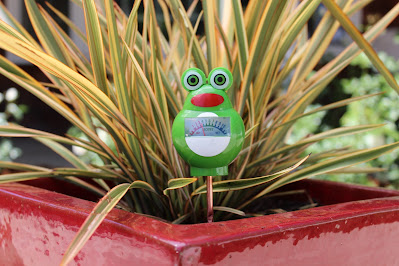
BeWaterSmart offers handy device to have during drought or any time

|
|
A moisture meter can tell you whether a potted plant
or a planted area needs water. This cute meter is
available free. (Photo courtesy BeWaterSmart)
|
Here is a must-have tool for summer gardening in Sacramento. It’s super-easy to use and will save you money. It can save an amazing amount of water, too, while looking adorable.
And the best part: It’s free! But only while the supply lasts.
BeWaterSmart.info once again is offering free soil moisture meters. Just stick the meter’s metal probe into the ground and it reads the moisture level almost instantly. And the little froggy is very cute while doing this important job.
BeWaterSmart is sponsored by the Regional Water Authority, the umbrella organization over the Sacramento region's water providers. The meters are available to any customers of those member water districts and providers.
During triple-digit weather, anything above ground – including us – can dry out quickly. But what about your soil?
“Trying to figure out how much water your yard needs can be a mystery,” says BeWaterSmart. “You might think you can tell just by looking at your plants or by the weather reports, but the best and most accurate way is to check the soil’s moisture level with a moisture meter.”
Even during high heat, soil (especially clay) can retain its moisture. Mulch cuts down on moisture loss. So does shade (such as a tree’s canopy over its roots).
With the meter, probe a few different spots in your garden. (Potted plants, too.) Push the probe 6 to 8 inches into the soil; that’s the root zone. The meter’s dial reads “dry,” “moist” or “wet”; irrigate accordingly.
And if you can’t push it in at all, that area likely needs some deep watering.
For your free moisture meter: https://bewatersmart.info/check-the-soil-and-save/
For rebates and other resources: www.bewatersmart.info .
Comments
0 comments have been posted.Sacramento Digs Gardening to your inbox.
Sites We Like
Garden Checklist for week of July 21
Your garden needs you!
* Keep your vegetable garden watered, mulched and weeded. Water before 8 a.m. to reduce the chance of fungal infection and to conserve moisture.
* Feed vegetable plants bone meal, rock phosphate or other fertilizers high in phosphate to stimulate more blooms and fruiting. (But wait until daily high temperatures drop out of the 100s.)
* Don’t let tomatoes wilt or dry out completely. Give tomatoes a deep watering two to three times a week.
* Harvest vegetables promptly to encourage plants to produce more. Squash especially tends to grow rapidly in hot weather. Keep an eye on zucchini.
* Pinch back chrysanthemums for bushy plants and more flowers in September.
* Remove spent flowers from roses, daylilies and other bloomers as they finish flowering.
* Pinch off blooms from basil so the plant will grow more leaves.
* Cut back lavender after flowering to promote a second bloom.
* It's not too late to add a splash of color. Plant petunias, snapdragons, zinnias and marigolds.
* From seed, plant corn, pumpkins, radishes, winter squash and sunflowers.